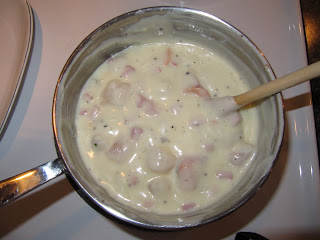This time around I'll make sushi. It's lighter and healthier, and the seafood chowder is more of a warming comforting wintery dish (perfect for our annual Christmas potluck):) Actually, to be more specific and technically correct what I am making is futomaki - sushi is the more general term used to describe cooked vinegared rice topped with seafood.
I thought hey I'm making sushi, while I'm at it why don't I blog about it? I'm not sure how many people make their own sushi at home, but it's sooo easy, so healthy and so delicious.
When I'm making sushi for other people, especially when it's being made the day before as is the case here, I always use fish that is cooked and I avoid the raw stuff for obvious reasons. We have on occasion, however, purchased sushi grade salmon from a local fishmonger, and we feast on salmon sashimi and sushi along with raw oysters (with my husband's special fiery sauce that I still think he should try to sell to Rodney's Oyster House downtown because it is an AWESOME recipe) **patting my honey on the back**
The sushi rolls I am making are a modified California Roll.
The ingredients, equipment and instructions are as follows:
Ingredients
5 cups Calrose rice
8 tbsp sugar (a little < 2 tbsp per cup of uncooked rice)
2 tsp sea salt
1/2 cup white vinegar or rice vinegar
nori sheets
3 ripe avocados
2 english cucumbers
imitation crab legs
masago (cured caplin roe - optional)
wasabi paste
soya sauce
Rice Paddle or curved wooen spatula
Basting Brush
Sushi Mat
Non serrated knife

1) Rinse rice in several changes of cold water. Cook rice in rice cooker.
2) While rice is cooking, prep filling ingredients and equipment. The key to making sushi with ease is to be organized and have everything prepared and organized 'assembly line style' before commencing the rolling:

Cut ends off cucumber, matching the length of the cucumber to the dimension of the nori sheets (. Cut cucumber longitudinally into quarters. Remove all seeds from cucumber with knife. Set aside.

Slice imitation crab legs longitudinally (approx. 1/4 inch thick). Set aside.
Remove peel and pits from avocados. Slice avocados into thin slices (approx. 1/8 inch thick). Set aside.
Set masago aside with a spoon.
Prepare nori sheets and bamboo rolling mat and set aside.
Prepare a small bowl of room temperature water with a basting brush. Set aside.
Have ready a plastic rice paddle or flat wooden spatula (no holes) with a dipping bowl of water.
Set aside a clean cutting board, and a non serrated knife sitting in a tall vessel filled with luke warm water.
Transfer cooked rice into a large mixing bowl. Stir in sugar, salt and vinegar, mix thoroughlly, allowing the stirring process to blend ingredients and also to cool the rice. Rice should have a shiny appearance. Let stand for 10 minutes.

Place a sheet of nori on rolling mat, shiny side down, with perforations perpindicular to the bamboo in the rolling mat, and with edge of nori sheet flush with edge of rolling mat closest to you.
With rice paddle, starting at front edge spread rice over top of nori sheet, *press with downward pressure so as to compact, flatten and 'push' rice rather than 'pulling' and 'spreading' rice as this will tear the nori. Use enough rice to make a 1/4 inch thick layer covering approx. 3/4 the nori sheet. This technique requires a little practice. Dip the paddle in water as required to moisten and avoid sticking of rice to the paddle.

Arrange imitation crab legs, cucumber, avocado, (and masago if used) in center of rice layer. (Visually divide rice layer into thirds. Filling ingredients shouldn't extend beyond middle third portion of rice layer or roll will be too full and ingredients will be squeezed out during rolling)

Lift front edge of rolling mat, and start rolling (away from yourself).
Use your thumbs and palms to advance roller and curl your fingers inside the roll to keep ingredients snugly 'tucked in' as you roll. Ensure the rolling mat is squeezed rather tightly as you roll or else rolls will be 'loose'.

Once the edge of the rolling mat is in contact with the rice layer on the far side, pull out on far edge of mat, and pull rolled part of mat towards you to ensure roll is tight.

Lift the edge of the mat up and continue advancing rolling mat until all rice is encorporated into the sushi roll and you are left with just the remaining 1/4 of the nori sheet.
Lightly brush the remaining end of the nori sheet with water, and finish rolling (the water will help the nori stick to itself ensuring that your roll will not come apart).

"Wa-La"!! You've done it, you've made a Maki Roll!! Set roll aside on a cutting board and start the process all over again for the next roll.

Once all rolls are constructed, use your wet knife to slice into about 1 1/2 inch thick discs.

Arrange on serving platter. Serve with wasabi paste and soya sauce for dipping :)

yummmmy, gotta sudden craving for some nice warm sake,
Cheers!! :)









































